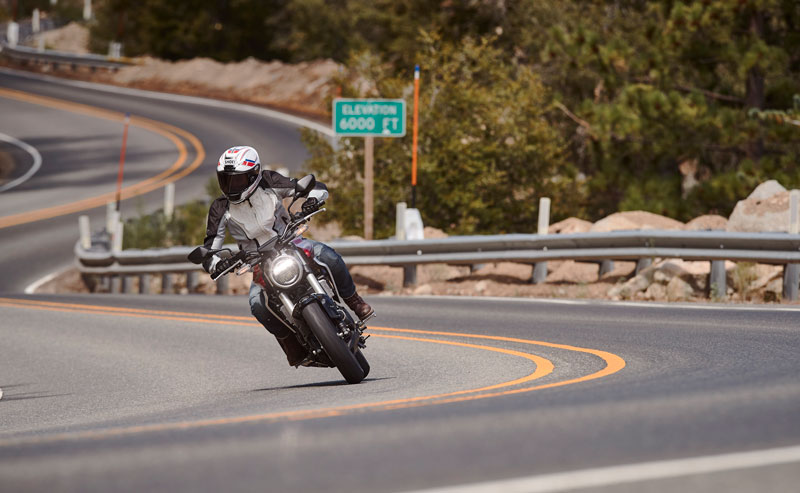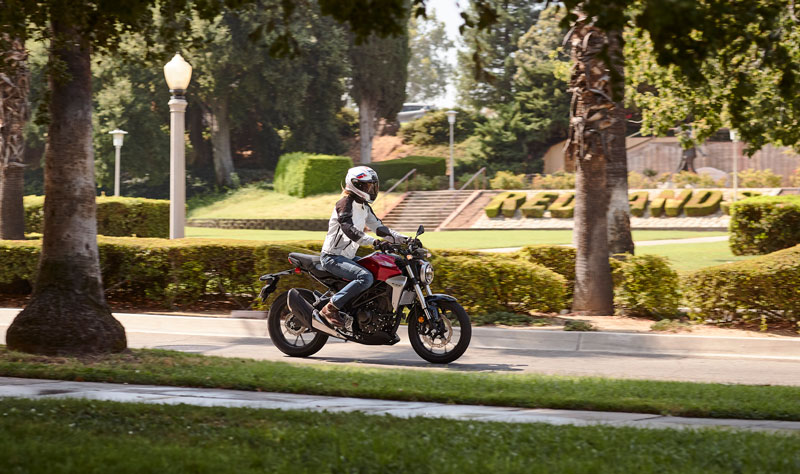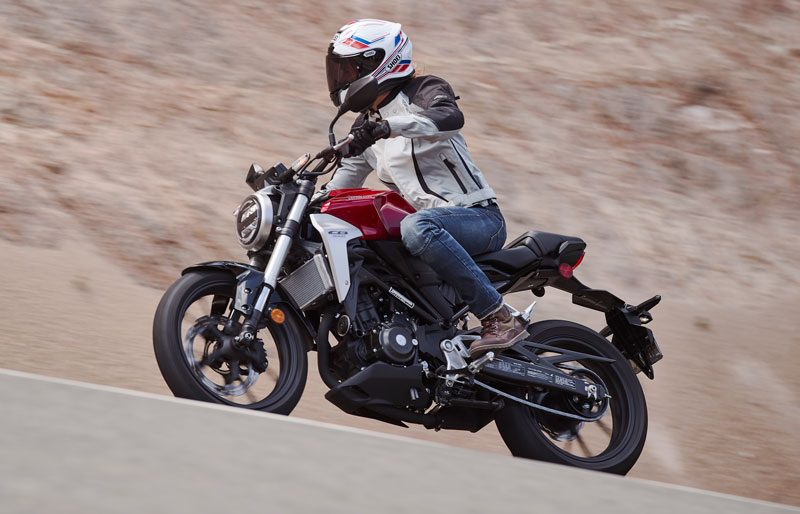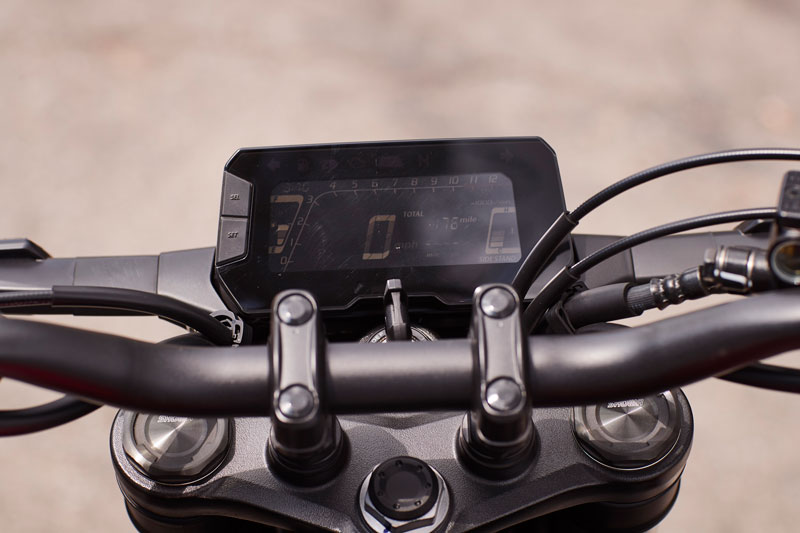If you’re into smaller bikes, times are good. Small bikes are no longer tragically un-hip, parts bin afterthoughts, and unlike the year 2000, when I bought my first brand new moto, there’s something out there for everyone. Even the Rebel is cool. Good times, indeed.
And if what you’re looking for is something easy to handle, lightweight and capable of cruising at 75 mph all day, with today’s trendy neo-retro look and a sub-$5,000 price tag, make your way to your local Honda dealer (there are more than 1,200 nationwide) and ask to see the 2019 CB300R.

The CB300R replaces the CB300F for the 2019 model year, and as far as I can tell it’s a better bike in every way. The F’s sporty naked-bike styling was getting a little stale in my eyes, but the R’s improvements go a long way past a restyle. The new bike is smaller, lighter and tighter, with a new chassis and suspension and available IMU-based 2-channel ABS.
The IMU is pitch-sensitive, so in extreme or “panic” braking situations, it senses rear wheel lift and adjusts braking to keep both tires planted, maximizing stopping power—a trick system for such an affordable bike.

Honda says its focus when recreating the CB300 was weight savings, so just about every change interacts with that goal in some way. The biggest is the chassis, a two-piece design with a tubular steel main frame and a separate, strengthened pivot plate to which the rear shock mounts. A new shorter swingarm with a gull-wing design on the right side allows the new muffler to be mounted as far inboard as possible for mass centralization.
Thanks largely to the chassis and exhaust changes, claimed wet weight on the standard CB300R is only 313 pounds. Our ABS-equipped test bike weighs 318 pounds wet, so that’s a loss of 36 pounds vs. the outgoing CB300F ABS. That also makes it at least 32 pounds lighter than its closest competitor, BMW’s G 310 R.
For perspective, 318 pounds what Honda’s CRF250L dual-sport weighs; this is heavy dirt bike territory, on a highly capable street bike.

Handling has been improved with a 41mm non-adjustable Showa inverted fork replacing the old 37mm standard unit, a wider handlebar mounted for a more upright riding position, and a more horizontally-mounted rear shock with a larger piston valve and 7-position adjustable preload. Spring rates at both ends were tweaked for the lighter load, but at 135 pounds I still found it stiff enough for sporty riding.

Rake and trail have been tightened, which combined with the chassis and swingarm changes result in a 1-inch shorter wheelbase. Seat height did increase more than an inch, to 31.5 inches, but my boss with his 29-inch inseam was able to easily get the balls of both feet solidly on the ground.
Speaking of the seat, it leaves something to be desired, especially after a 100-plus-mile press launch ride around Big Bear Lake followed by another 110 freeway miles home. It’s hard and thin, and can dig uncomfortably into the rider’s thighs at a stop. With feet on the pegs it’s better, but my bum cried “uncle” after 40 numbing miles on I-210. Fortunately it was time for a gas stop, and 1.996 gallons of regular later I calculated I had been on track to get almost 200 miles from my first 2.7-gallon tankful.

The 286cc DOHC single is mostly unchanged, although Honda says the intake was revised slightly for better airflow, resulting in improved acceleration performance. On the freeway, it works hard but will cruise at 75 to 80 mph (necessary to avoid being run over by SoCal drivers taking advantage of those rare occasions when they aren’t crawling along in six lanes of traffic purgatory) for as long as your rear end can take it.
It’s also worth noting that maintaining those speeds continuously will do a number on your fuel economy; mine dropped from an impressive 73.8 mpg on the mix of city and canyon riding of the press launch to 54.5 during my wide-open-throttle freeway sprint home.

OK, so the CB300R isn’t the most freeway-friendly moto, but in its element—around town and on twisty roads—the little CB shines. The short wheelbase, comfortable, upright riding position and light weight combine to create an extremely agile, fun ride. Power delivery is smooth and controlled, and the tighter the twisties the better; keep the revs up and you’ll have just as much fun—if not more—as you would on a more powerful machine.
We’ll be putting more miles on our CB300R in the coming weeks, so look for a more thorough Road Test Review in the near future. But so far, we have to say the “neo-sports café” R is the step forward the CB300 needed and it should be on your short list if you’re a new rider or simply want something small, light and fun.

2019 Honda CB300R Specs
Base Price: $4,649
Price as Tested: $4,949 (ABS)
Website: powersports.honda.com
Engine Type: Liquid-cooled, DOHC single, 4 valves per cyl.
Displacement: 286cc
Bore x Stroke: 76.0 x 63.0mm
Transmission: 6-speed, wet multi-plate clutch
Final Drive: O-ring chain
Wheelbase: 53.3 in.
Rake/Trail: 24.7 degrees/3.7 in.
Seat Height: 31.5 in.
Wet Weight: 318 lbs.
Fuel Capacity: 2.7 gals.
MPG: 64.6 (avg.)














This looks like the best beginner bike out now, but as a short rider (5’5″ on a good day) it was pretty disappointing to see that they raised the seat height. Do you know if they offer a lower seat height or a lowering kit? Otherwise the Rebel might be the way to go, though I prefer the style and ergonomics of this.
Given how thin and hard the seat already is, I doubt Honda will offer a shorter one. Seat height is tough on sporty naked bikes like this, just due to the chassis design. I’d recommend still going to your dealer and sitting on one…you might be surprised how accessible it is given its super light weight and the skinny seat design.
they do offer a lower more comfortable seat that lowers the bike 1.5 inches and makes the seat narrower
Where can I find this lower seat you mentioned? I don’t believe they have it at my local dealers
Hi Emi, did you ever find out? I’m looking for this too.
You don’t need to flat foot when your at a light, one foot down is sufficient. Quite a few riders with those 35″ seat height dual sport bikes can’t flat foot either.
This is one of the best bikes for Honda and 300 cc segment . But it’s too pricey in India . I wish I wanted one cb300r .buts ok Let’s I’m waiting for it’s sibling cb250r for reasonable price to launch in India.
Being 5 feet 2 inch myself, I ride my CB300R quite comfortably, the bike is quite light and easy to handle, absolutely no problem in handling.